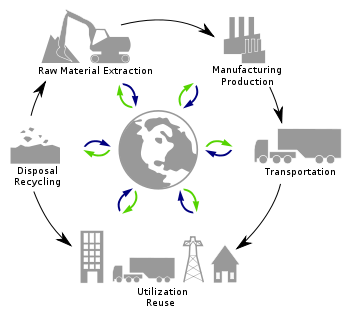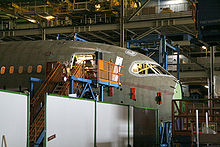- Manufacturing
-
Part of a series of articles on Industry 
Manufacturing methods Improvement methods Information & communication Process control
Manufacturing is the use of machines, tools and labor to produce goods for use or sale. The term may refer to a range of human activity, from handicraft to high tech, but is most commonly applied to industrial production, in which raw materials are transformed into finished goods on a large scale. Such finished goods may be used for manufacturing other, more complex products, such as aircraft, household appliances or automobiles, or sold to wholesalers, who in turn sell them to retailers, who then sell them to end users – the "consumers".Manufacturing takes turns under all types of economic systems. In a free market economy, manufacturing is usually directed toward the mass production of products for sale to consumers at a profit. In a collectivist economy, manufacturing is more frequently directed by the state to supply a centrally planned economy. In free market economies, manufacturing occurs under some degree of government regulation.
Modern manufacturing includes all intermediate processes required for the production and integration of a product's components. Some industries, such as semiconductor and steel manufacturers use the term fabrication instead.
The manufacturing sector is closely connected with engineering and industrial design. Examples of major manufacturers in North America include General Motors Corporation, General Electric, and Pfizer. Examples in Europe include Volkswagen Group, Siemens, and Michelin. Examples in Asia include Toyota, Samsung, and Bridgestone.
Contents
History and development
- In its earliest form, manufacturing was usually carried out by a single skilled artisan with assistants. Training was by apprenticeship. In much of the pre-industrial world the guild system protected the privileges and trade secrets of urban artisans.
- Before the Industrial Revolution, most manufacturing occurred in rural areas, where household-based manufacturing served as a supplemental subsistence strategy to agriculture (and continues to do so in places). Entrepreneurs organized a number of manufacturing households into a single enterprise through the putting-out system.
- Toll manufacturing is an arrangement whereby a first firm with specialized equipment processes raw materials or semi-finished goods for a second firm.
Manufacturing systems: The changing methods of manufacturing
- Craft or Guild system
- Putting-out system
- English system of manufacturing
- American system of manufacturing
- Soviet collectivism in manufacturing
- Mass production
- Just In Time manufacturing
- Lean manufacturing
- Flexible manufacturing
- Mass customization
- Agile manufacturing
- Rapid manufacturing
- Prefabrication
- Packaging and labeling
- Ownership
- Fabrication
- Publication
Economics of manufacturing
According to some economists, manufacturing is a wealth-producing sector of an economy, whereas a service sector tends to be wealth-consuming.[1][2] Emerging technologies have provided some new growth in advanced manufacturing employment opportunities in the Manufacturing Belt in the United States. Manufacturing provides important material support for national infrastructure and for national defense.
On the other hand, most manufacturing may involve significant social and environmental costs. The clean-up costs of hazardous waste, for example, may outweigh the benefits of a product that creates it. Hazardous materials may expose workers to health risks. Developed countries regulate manufacturing activity with labor laws and environmental laws. Across the globe, manufacturers can be subject to regulations and pollution taxes to offset the environmental costs of manufacturing activities. Labor Unions and craft guilds have played a historic role in the negotiation of worker rights and wages. Environment laws and labor protections that are available in developed nations may not be available in the third world. Tort law and product liability impose additional costs on manufacturing.
Manufacturing may require huge amounts of fossil fuels. Automobile construction requires, on average, 20 barrels of oil.[3]
Manufacturing and investment
Surveys and analyses of trends and issues in manufacturing and investment around the world focus on such things as:
- the nature and sources of the considerable variations that occur cross-nationally in levels of manufacturing and wider industrial-economic growth;
- competitiveness; and
- attractiveness to foreign direct investors.
In addition to general overviews, researchers have examined the features and factors affecting particular key aspects of manufacturing development. They have compared production and investment in a range of Western and non-Western countries and presented case studies of growth and performance in important individual industries and market-economic sectors.[4][5]
On June 26, 2009, Jeff Immelt, the CEO of General Electric, called for the United States to increase its manufacturing base employment to 20% of the workforce, commenting that the U.S. has outsourced too much in some areas and can no longer rely on the financial sector and consumer spending to drive demand.[6] A total of 3.2 million – one in six U.S. manufacturing jobs – have disappeared between 2000 and 2007.[7] In the UK, EEF the manufacturers organisation has led calls for the UK economy to be rebalanced to rely less on financial services and has actively promoted the manufacturing agenda.
Manufacturing processes
- List of manufacturing processes
- Manufacturing Process Management
Manufacturing categories
- Chemical industry
- Pharmaceutical
- Construction
- Electronics
- Engineering
- Energy industry
- Food and Beverage
- Agribusiness
- Brewing industry
- Food processing
- Industrial design
- Metalworking
- Smith
- Machinist
- Machine tools
- Cutting tools (metalworking)
- Free machining
- Tool and die maker
- Global steel industry trends
- Steel production
- Metalcasting
- Plastics
- Telecommunications
- Textile manufacturing
- Clothing industry
- Sailmaker
- Tentmaking
- Pulp and paper industry
- Transportation
- Aerospace manufacturing
- Automotive industry
- Bus manufacturing
- Tire manufacturing
- Shipbuilding
Theories
Control
See also
References
- ^ Friedman, David (2006). "No Light at the End of the Tunnel". Los Angeles Times. New America Foundation. http://www.newamerica.net/publications/articles/2002/no_light_at_the_end_of_the_tunnel. Retrieved 2007-05-12.
- ^ Joseph, Keith (1976). "Monetarism Is Not Enough". Center for Policy Studies. Margaret Thatcher Foundation. http://www.margaretthatcher.org/commentary/displaydocument.asp?docid=110796. Retrieved 2007-05-12.
- ^ "World oil supplies are set to run out faster than expected, warn scientists". The Independent. June 14, 2007.
- ^ Manufacturing & Investment Around The World: An International Survey Of Factors Affecting Growth & Performance, ISR Publications/Google Books, revised second edition, 2002. ISBN 978-0-906321-25-6.
- ^ [1]
- ^ Bailey, David and Soyoung Kim (June 26, 2009).GE's Immelt says U.S. economy needs industrial renewal.UK Guardian.. Retrieved on June 28, 2009.
- ^ "Factory jobs: 3 million lost since 2000". USATODAY.com. April 20, 2007.
Sources
- Kalpakjian, Serope; Steven Schmid (August 2005). Manufacturing, Engineering & Technology. Prentice Hall. pp. 22–36, 951–988. ISBN 0-1314-8965-8.
External links
- Cato Institute article:Thriving in a Global Economy: The Truth about U.S. Manufacturing and Trade
- How Everyday Things Are Made: video presentations.
- TIME Magazine article on American manufacturing's global effectiveness
- Grant Thornton IBR 2008 Manufacturing industry focus
- MFGWatch - Quarterly Survey of North American Manufacturers
- - EEF, the manufacturers' organisation - industry group representing uk manufacturers
Categories:
Wikimedia Foundation. 2010.


